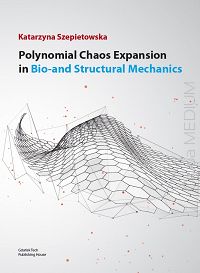Polynomial Chaos Expansion in Bio-and Structural Mechanics
- Dodaj recenzję:
- Kod: 5071
- Producent: Wydawnictwo Politechniki Gdańskiej
- Autor: Katarzyna Szepietowska
-
-
- szt.
- Cena netto: 27,62 zł 29,00 zł
Polynomial Chaos Expansion in Bio-and Structural Mechanics
rok wydania: 2022, wydanie pierwsze
ISBN: 978-83-7348-866-3
ilość stron: 127
format: A4
oprawa: miękka
Opis
This monograph presents a probabilistic approach to modelling the mechanics of materials and structures where the modelled performance is influenced by uncertainty in the input parameters. The work is interdisciplinary and the methods described are applied to medical and civil engineering problems. The motivation for this work was the necessity of mechanics-based approaches in the modelling and simulation of implants used in the repair of ventral hernias. Many uncertainties appear in the modelling of the implant-abdominal wall system. The probabilistic approach proposed in this monograph enables these uncertainties to be propagated to the output of the model and the investigation of their respective influences. The regression-based polynomial chaos expansion method is used here. However, the accuracy of such non-intrusive methods depends on the number and location of sampling points. Finding a universal method to achieve a good balance between accuracy and computational cost is still an open question so different approaches are investigated in this monograph in order to choose an efficient method. Global sensitivity analysis is used to investigate the respective influences of input uncertainties on the variation of the outputs of different models. The uncertainties are propagated to the implant-abdominal wall models in order to draw some conclusions important for further research. Using the expertise acquired from biomechanical models, modelling of historic timber joints and simulations of their mechanical behaviour is undertaken. Such an investigation is important owing to the need for efficient planning of repairs and renovation of buildings of historical value.
Spis treści
Contents
Symbols / 7
1. Introduction / 11
1.1 Ventral Hernia / 11
1.1.1 Mechanics based approach for ventral hernia repair / 12
1.1.2 Need of probabilistic approach / 18
1.2 Uncertainty Quantification / 19
1.2.1 Uncertainty quantification in biomechanics and structural mechanics / 20
1.3 Objectives / 21
1.4 Outline / 22
2. Uncertainty quantification and sensitivity analysis / 23
2.1 Uncertainty quantification methods / 23
2.1.1 Sampling-based methods / 23
2.1.2 Spectral methods / 24
2.2 Sensitivity analysis / 29
2.2.1 Local sensitivity analysis / 30
2.2.2 Global sensitivity analysis / 30
3. Comparison of regression point choice methods / 35
3.1 Methods to choose regression points in nonintrusive polynomial chaos expansion / 35
3.1.1 Random and quasi-random choice / 36
3.1.2 Optimality criteria / 36
3.1.3 Combined approach / 39
3.1.4 Summary of methods / 40
3.2 Comparison of methods on numerical examples / 42
3.2.1 Examples / 43
3.2.2 Results on 1D-dimensional examples / 48
3.2.3 Results of comparison on multivariate examples / 70
3.3 Conclusions / 81
4. Results of uncertainty propagation and sensitivity analysis / 85
4.1 Cable model (model 1) / 85
4.2 Model of membrane subjected to forced displacement of supports / 88
4.2.1 10-D problem with independent variables / 88
4.2.2 Reduction of number of variables / 88
4.2.3 Correlated variables / 90
4.3 Model of membrane subjected to intraabdominal pressure / 95
4.3.1 Deterministic model / 95
4.3.2 Uncertainties in pressure and elasticity of the abdominal wall tissues / 97
4.3.3 Model of membrane subjected to pressure with fixation imperfections / 99
4.4 Membrane model of abdominal wall with implant / 103
4.4.1 Model / 103
4.4.2 Results / 104
4.5 Civil engineering application: corner joints in historic log houses / 107
6. Contents
4.5.1 Background / 107
4.5.2 Model / 108
4.5.3 Results / 110
4.6 Conclusions / 116
5. Conclusions 119
A Technical information on implementation of probabilistic models and sensitivity analysis / 123
A.1 Used tools / 123
A.2 Multivariate polynomials / 124
A.3 Correlation matrices / 124
Bibliography / 127


